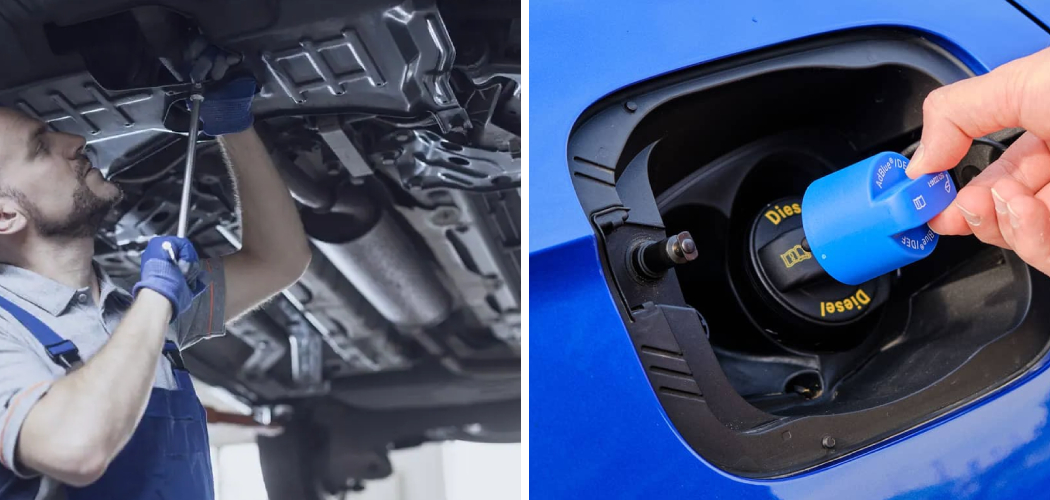Have you ever gotten the dreaded SCR system fault message on your dashboard and wish it would disappear? You’re not alone – many modern diesel vehicles come equipped with Selective Catalytic Reduction systems that rely on diesel exhaust fluid (DEF) to reduce emissions.
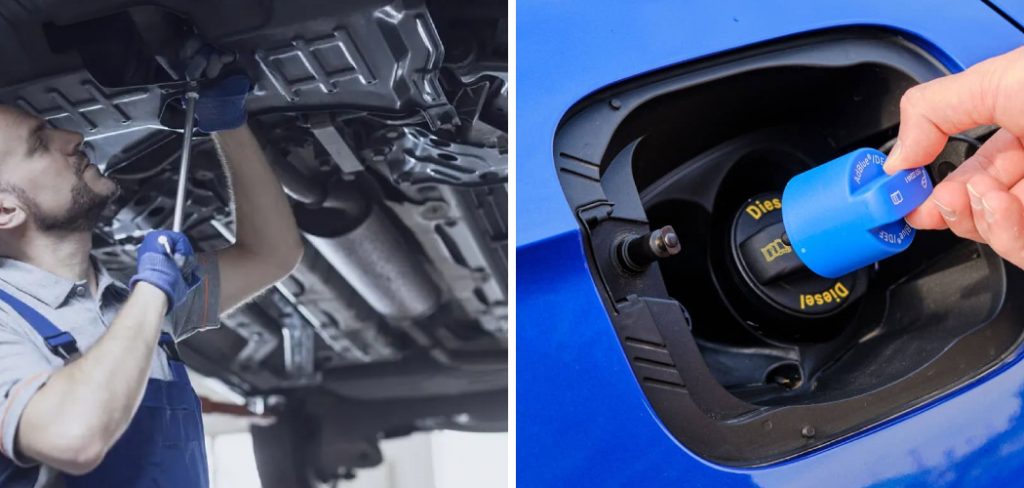
But keeping those systems happy can sometimes be a headache. Between refilling the DEF tank and clearing fault codes, it’s enough to make anyone pull their hair out. But have no fear – resetting an SCR fault doesn’t have to be complicated or expensive.
In this post, I’ll walk you through the simple steps on how to reset exhaust fluid system fault. By the end, you’ll feel confident dealing with DEF system issues and saving a bundle on repair shop fees. Let’s get started!
What Will You Need?
Before diving into the reset process, gathering some essential tools and information is important. These include:
- OBD-II Scanner: This is a must-have tool for any vehicle owner. It allows you to retrieve diagnostic trouble codes (DTCs) from your car’s computer system and clear them if necessary.
- Owner’s Manual: Different car makes and models may have slightly different reset procedures. The manual will be useful if you need clarification on the exact steps to follow.
- DEF Fluid: Check your DEF tank to ensure it’s full before resetting the system. If it’s low or empty, refill it with a fresh DEF solution.
Once you’ve gathered all the necessary items and information, follow these steps to reset your DEF system fault successfully.
10 Easy Steps on How to Reset Exhaust Fluid System Fault
Step 1. Startup the Vehicle:

Start your vehicle and let it idle for a few minutes. This will allow the systems to fully boot up and get ready for the fault reset process. It will also help the OBD-II scanner to establish a stable connection with your vehicle’s onboard computer system.
Step 2. Connect the OBD-II Scanner:
Locate the diagnostic link connector (DLC) in your vehicle – generally, it’s found under the driver’s side dashboard. Plug the OBD-II scanner into the DLC. Once connected, the scanner should power up and establish a connection with your vehicle’s computer system.
Step 3. Select the ‘Read Codes’ Option:
On your OBD-II scanner’s menu, navigate to and select the ‘Read Codes’ option. This will prompt the device to scan your vehicle’s computer for stored fault codes. Make a note of any codes related to the exhaust fluid system. These codes will assist you in determining the exact nature of the fault. Ensure you understand what each code means before proceeding. Refer to your vehicle’s manual or conduct an online search if you need clarification.
Step 4. Clear the Codes:
After noting the codes, navigate to the ‘Erase Codes’ or ‘Clear Codes’ option on your OBD-II scanner. Select this option to erase the fault codes from your vehicle’s computer system. Confirm the action if prompted. This will typically cause the fault warning light on your dashboard to turn off. However, if the underlying issue causing the fault has not been resolved, the light may return after a while. If this happens, further troubleshooting may be required.
Step 5. Check the DEF Fluid Level:
After clearing the codes, turn off the engine and check the level of DEF in your tank. If it’s low or empty, fill it up with fresh DEF fluid. Ensure the fluid you’re using is compatible with your vehicle.
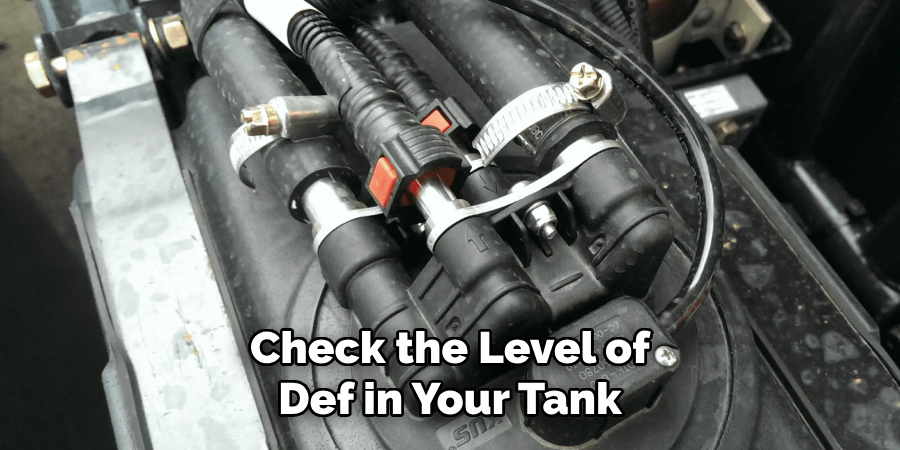
After refilling, secure the tank cap and clear any spilled fluid. Start the engine again and let it idle for a few minutes to allow the system to recognize the new fluid level. If the fault was triggered due to a low DEF level, this should clear it.
Step 6. Restart the Vehicle:
After letting the vehicle idle for a few minutes, turn off the engine completely. Wait 30 seconds to a minute, and then start your car again. This process is often known as a “hard reset” and can help your vehicle’s computer system recognize that the issue has been addressed and the DEF level is now adequate. Observe your dashboard; if the fault light doesn’t come back on, the fault has successfully been reset. If it does, proceed to the next step.
Step 7. Conduct a Test Drive:
After the successful hard reset, take your vehicle for a short test drive. This allows the computer system to recognize all changes and ensure everything fully functions. Drive at a moderate speed for about 10 to 15 minutes, keeping a close eye on your dashboard for any fault indicators. If the light does not come on during this period, it indicates that the fault has been successfully reset. If the light does reappear, it suggests an underlying issue that may need more attention.
Step 8. Consult a Professional:
If the fault light continues to appear despite following all the above steps, it may be time to consult a professional. Persistent fault warnings could indicate a more complex issue with your exhaust fluid system that needs expert attention.
Professional mechanics have specialized diagnostic tools and extensive experience troubleshooting DEF system faults. They can pinpoint the underlying problem and recommend the most effective action. While this may involve some cost, it ensures the longevity and optimal performance of your vehicle’s emission control system.
Step 9. Regular Maintenance:
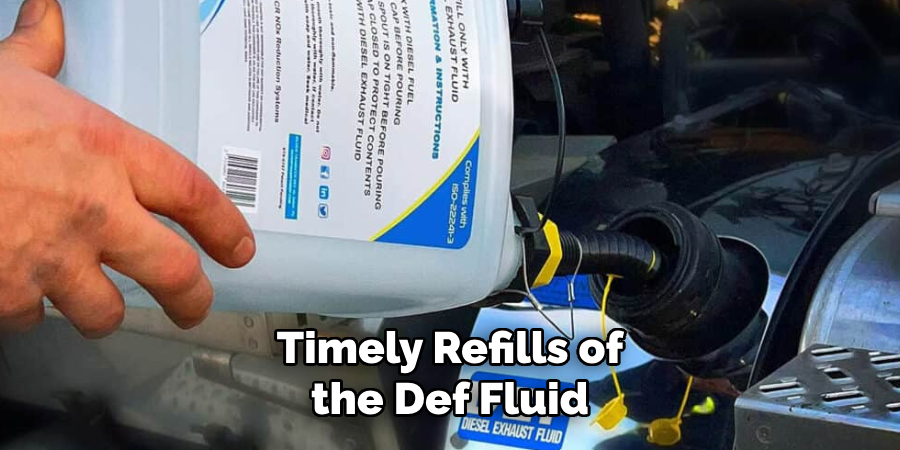
Remember that prevention is better than cure. Follow a regular maintenance schedule for your vehicle, including the DEF system. Regular checks and timely refills of the DEF fluid can prevent most faults.
If the issues persist even after regular maintenance, it could indicate a deeper problem requiring professional help. Keeping up with regular maintenance will ensure your vehicle runs smoothly and will help you catch potential issues before they develop into significant faults.
Step 10. Learn from the Experience:
Every fault and troubleshooting process provides an opportunity to understand your vehicle better. Reflect on what might’ve caused the exhaust fluid system fault, the signs your vehicle showed leading to it, and how you could prevent it in the future.
This awareness will be invaluable in maintaining the health of your vehicle’s exhaust system, reducing the chances of recurring faults, and improving overall vehicle performance. Remember, the more knowledge you have about your car, the better equipped you are to handle eventualities and ensure its long-term well-being.
By following these steps, you can effectively reset the exhaust fluid system fault and prevent it from occurring in the future.
5 Additional Tips and Tricks
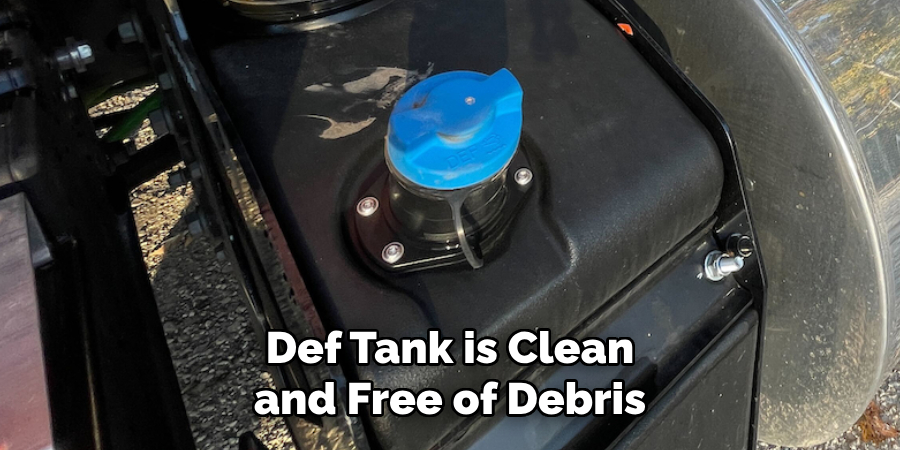
- Understand the Role of DEF: Diesel Exhaust Fluid (DEF) plays a critical role in cleaning diesel emissions and reducing your vehicle’s environmental impact. Understanding how it works can assist you in diagnosing and addressing issues more effectively.
- Quality Matters: Always use high-quality DEF. Cheaper or substandard DEF may harm your vehicle’s DEF system, leading to more issues.
- Storage Conditions: Store DEF in a cool, dry place and avoid exposure to direct sunlight, which can degrade the fluid’s quality.
- Avoid Cross-Contamination: Ensure that the container or funnel used to refill the DEF tank is clean and free of debris or residues of other fluids. Cross-contamination can cause DEF system faults.
- Stay Updated: Software updates from your vehicle’s manufacturer often include improvements to the vehicle’s onboard diagnostic systems. Updating your vehicle’s software can help identify and prevent DEF system faults.
With these additional tips and tricks, you can proactively maintain your vehicle’s exhaust fluid system and ensure optimal performance.
5 Things You Should Avoid
- Ignoring Warning Signs: Don’t ignore fault indicators on your dashboard. If the DEF system fault light comes on, it signals something is wrong. Ignoring it could lead to more severe problems down the line.
- Delaying DEF Refills: Avoid running your DEF tank dry. Regularly check your DEF levels and refill the tank as needed. Running out of DEF can trigger a system fault.
- Using the Wrong DEF: Not all DEFs are the same. Make sure to use the correct DEF that is compatible with your vehicle. Using incorrect DEF can lead to system malfunctions.
- Improper Handling of DEF: Direct skin contact or inhalation of DEF can be harmful. Always use appropriate safety measures while handling DEF.
- Neglecting Regular Maintenance: Failing to follow a consistent maintenance schedule can break the DEF system. Regular maintenance checks can help preempt potential issues and ensure the system’s efficient functioning.
By avoiding these common mistakes, you can minimize the chances of encountering DEF system faults and keep your vehicle running smoothly.
Conclusion
In conclusion, a faulty exhaust fluid system can quickly become a major headache for any vehicle owner. But with the proper knowledge and steps, it is a problem that can soon be resolved.
By following the tips and tricks outlined in this blog post, you should now better understand how to reset exhaust fluid system fault. Remember to regularly maintain your vehicle and always use high-quality DEF fluid to avoid future issues. If you are still experiencing problems, feel free to consult with a professional mechanic. With proper care and maintenance, your exhaust fluid system will continue functioning smoothly and efficiently for miles to come.
So go ahead and give your vehicle the TLC it needs by resetting the exhaust fluid system fault today! You’ll be back on the road, confident in your vehicle’s performance and grateful for overcoming this obstacle. Let’s spread the knowledge and keep our vehicles running at their best. Thank you for reading and happy driving!

